Hackberry Trees (Celtis): Common Types, Leaves, Bark, Fruit (Pictures) – Identification
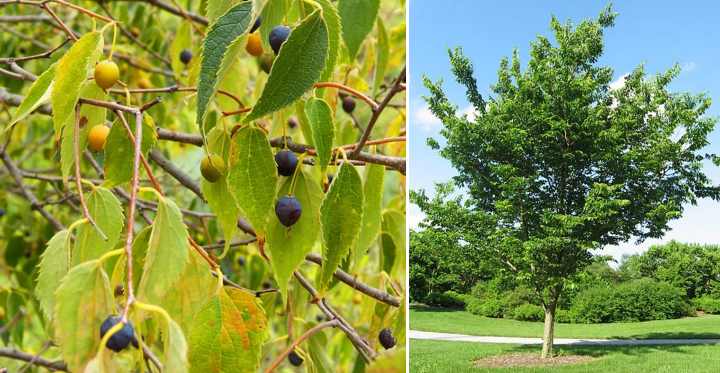
Hackberry (Celtis) is a group of medium-sized, deciduous trees with long ovately-shaped leaves, clusters of small fuzzy spring flowers, and small purple fruits. Low-maintenance hackberry trees are hardy trees that withstand many conditions, including drought, wet soil, strong winds, and air pollution. The tree’s dense, spreading foliage and rounded crown make hackberries ideal shade trees or lawn trees in garden landscapes.
This article is a guide to identifying the common types of hackberry trees. Descriptions and pictures of hackberry leaves, bark, flowers, and fruit will help you recognize these sturdy landscape trees.
Hackberry Tree (Celtis) Facts
The hackberry tree is a deciduous tree that grows 40 to 60 ft. (12 – 18 m) high and wide. The attractive landscape tree has a pyramidal crown when immature. As the tree grows, the tree develops an open, spreading canopy of arching zigzag branches that droop at the ends.
Hackberries are recognized as being sturdy, robust trees that grow in most environments. Therefore, you will find native hackberry trees growing in most soil types, from poor to fertile ground.
Around 60 species of hackberry trees in the genus Celtis. The common hackberry (Celtis occidentalis) is native to many states in the Midwest and Eastern areas of North America. In addition, some species of hackberry, like the sugarberry (Celtis laevigata), are common in Texas and other warm states in the south.
Most hackberry trees thrive in USDA zones 2 to 9. The sugarberry—or southern hackberry—grows best in zones 5 to 10. However, most trees in the genus Celtis withstand frost.
Species of hackberries have common names like sugarberry, sugar hackberry, nettle tree, American hackberry, and beaverwood tree. Both the Celtis occidentalis and Celtis laevigata share the name sugarberry—referring to the sweet drupes that ripen in the fall.
Hackberry trees are related to elm trees in the deciduous tree order Rosales. Looking at hackberry tree leaves and American elm leaves, you will notice the leaves look the same. The cork-like bark is the easiest way to tell hackberries apart from elm trees. The common hackberry is sometimes called a false elm tree.
Hackberry Tree Leaves
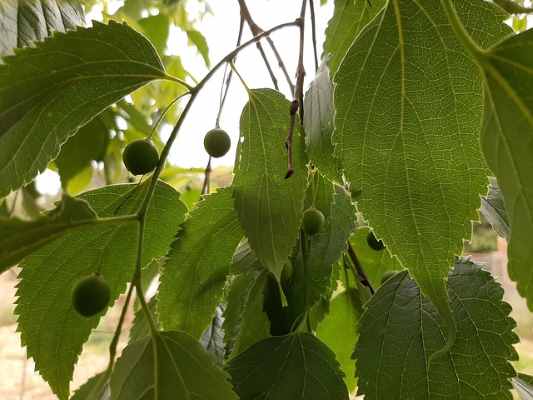
Hackberry tree leaves are identified by their serrated margins and rough texture. Also in the picture are green immature hackberry fruit
Hackberry leaves are identified by their characteristic rough texture. Hackberry leaves have a recognizable ovate-lanceolate shape with serration along the entire margins. Hackberry leaves measure 2” to 5” (5 – 12 cm) long and up to 3.5” (9 cm) wide. You’ll notice an asymmetric base on the dull to glossy green leaves.
Leaves on hackberry trees are simple leaves that are arranged alternately on crooked branches. Each leaf hangs from a stem (petiole) that is 0.5” to 0.8” (1.3 – 2 cm) long. The leaves are light green on the top and paler green on the underside. In the fall, hackberry leaves turn an undistinguished yellow or pale green.
Hackberry Tree Bark
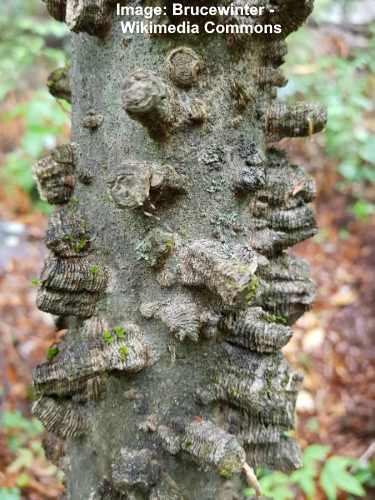
Hackberry bark has raised wart-like growths that are built up in ridges
Hackberry bark is its most recognizable feature. The smooth light brown or grayish Hackberry bark has characteristic wart-like growths, ridges, and a corky texture giving the tree’s bark a distinctive pattern. On some types of hackberries, the bark is as smooth as beech trees.
Hackberry Tree Flowers
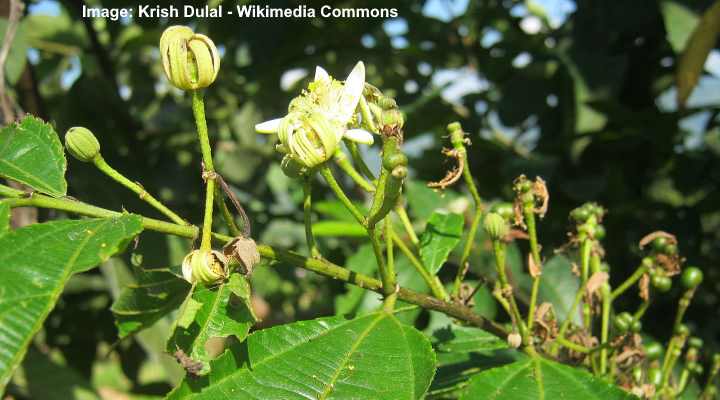
Flowers of Mediterranean hackberry (Celtis australis)
Hackberry flowers are small, insignificant yellowish-green flowers that each have four or five petals that bloom in spring. Both male and female flowers can appear on a single tree. Male hackberry flowers grow in fuzzy clusters, and female flowers are solitary. Flowers emerge on hackberries when the foliage appears.
Hackberry Tree Fruit
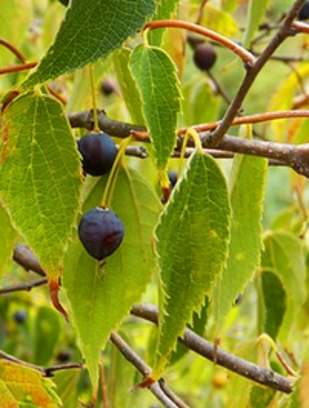
Hackberry mature fruit
Hackberry fruit is small round berry-like drupes that have a sweet taste. The tasty edible drupes grow as globular green fruits that mature to red and then a deep purple color. The fruit dangles on short stems. Hackberry fruit is ready for eating in September, and the berries persist on the tree throughout winter.
Hackberry Tree Identification
Hackberry leaves and bark make it easy to identify the tree in landscapes. Look for the smooth, grayish bark that has warty growths growing on projecting ridges. The pointed, ovate leaves have toothed margins and an asymmetrical, uneven base. The leaves and yellowish flower clusters grow on slender zigzag branches.
In landscapes, hackberry trees are recognizable by their open, spreading crown and arching branches with drooping tips.
Hackberry trees are easy to identify in the winter. The corky bark covered in ridges and wart-like growths along with masses of purple berries are the tree’s most recognizable characteristics when there’s no foliage on the branches.
Common Hackberry Tree Problems
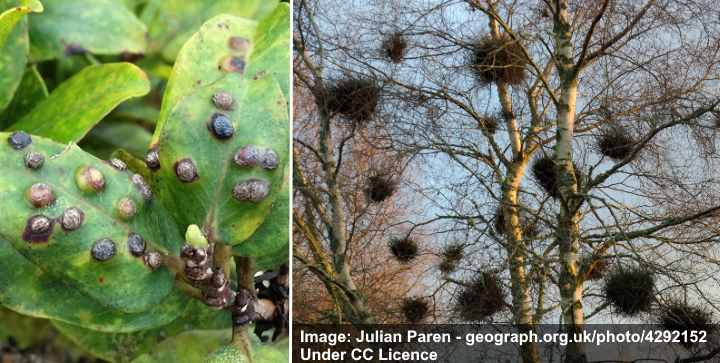
Common hackberry diseases are leaf galls (left) and witches’ broom (right)
Witches’ broom is a common disease that affects hackberry trees. This problem is a combination of powdery mildew and small mites that affect the tree’s growth. The condition causes a bush-like cluster of weak shoots to grow among branches and looks like a large bird’s nest. To get rid of the unsightly branch clusters, you need to prune the affected branches.
A type of plant lice called psyllids can cause hackberry nipple galls to grow on the underside of leaves. The insects feed on the leaf tissue, causing a distinctive gall to appear. Typically, hackberry leaf galls don’t damage the tree’s health. However, large infestations can result in early leaf drop.
Hackberry trees are typically tough trees that are not prone to disease or pests. However, common tree pests such as woolly aphids, scale insects, and caterpillars can feed on tree tissue, affecting its growth.
Types of Hackberry Trees (With Pictures)
Let’s look at the identifying features of common species of hackberry trees. You will learn how to identify the trees by examining the ovate leaves, corky bark, and small clusters of yellowish-green flowers.
Common Hackberry Tree (Celtis occidentalis)
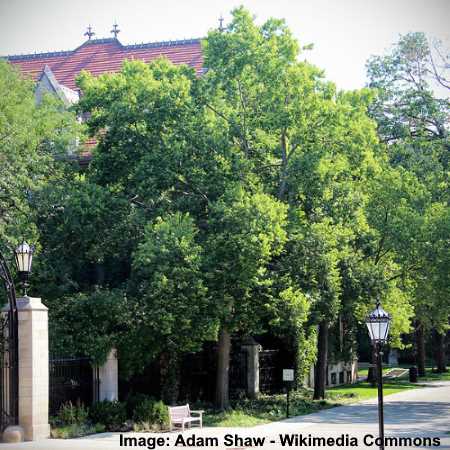
Common hackberry tree (Celtis occidentalis)
Common hackberry is a medium to large tree with deciduous glossy to dull green pointed leaves, gray bark, small yellowish flowers, and purple berries. Mature hackberries have an oval, spreading crown with slightly pendulous branches. Common hackberries grow between 40 and 60 ft. (12 – 18 m) tall and wide.
The common hackberry is a fast-growing tree that thrives in most conditions. The tree grows just as well in full sun or deep shade. They are commonly found growing in rocky, loamy soil but also perform well in clay soil. Although hackberry trees prefer well-drained moist ground, they survive some drought and flooding.
The growing zones for the common hackberry are USDA 2 to 9.
Common hackberries are attractive landscaping trees in all seasons. In spring, dense foliage and clusters of flowers cover the crooked branches. In summer, purple fruits develop before the leaves turn yellow in the fall. After the leaves drop, the light brown corky bark with its wart-like protrusions provides winter interest.
Common hackberry produces dense foliage consisting of ovate leaves that measure 2” to 5” (5 – 13 cm) long. The leaves are identified by their toothed edges, lopsided rounded base, and visible veining. In the fall, leaves on common hackberries turn an undistinguished yellow.
Although the common hackberry is a flowering tree, it’s not noted for its fancy blooms. Instead, fuzzy clusters of tiny yellowish-green flowers bloom in mid- to late-spring (April and May) and bloom for a few weeks. The flowers consist of four or five petals and yellowish stamens.
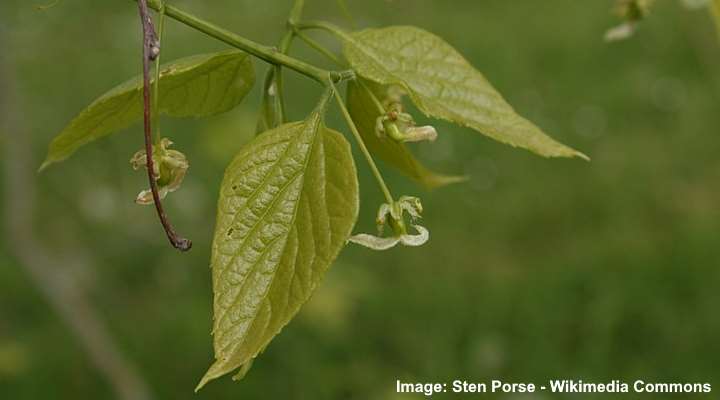
Common hackberry flower
Female flowers develop into small globular purple berry-like fruits. Each round, fleshy fruit contains a single seed. The sweet drupes are popular for birds, and you can eat them raw or use them to make delicious jelly.
In residential gardens, common hackberry trees are popular shade trees thanks to their broad, arching crown. You can also grow this hackberry species as a lawn tree and control its height by regular pruning.
An issue with growing a common hackberry in your backyard is that it’s a messy tree. The masses of autumn leaves and the number of seeds can create clean-up problems. However, this is usually only an issue if the tree is near driveways, patios, or sidewalks.
Hackberry Tree Bark: Brown or gray ridged or grooved bark with characteristic corky warts, especially at the base of the hackberry tree trunk.
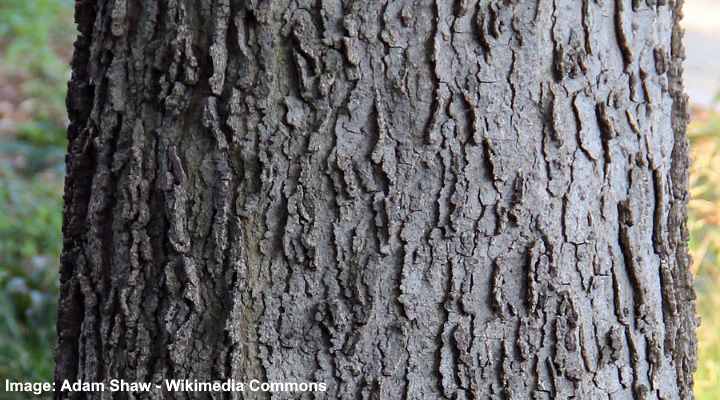
Common hackberry bark
Hackberry Tree Leaves: Oval to lance-shaped leaves with a tapering point, serrated edges, and asymmetrical rounded base. The leaves measure 3” to 6” (7.5 – 15 cm) long. The deciduous leaves are dull to glossy green in summer and yellow in the fall.
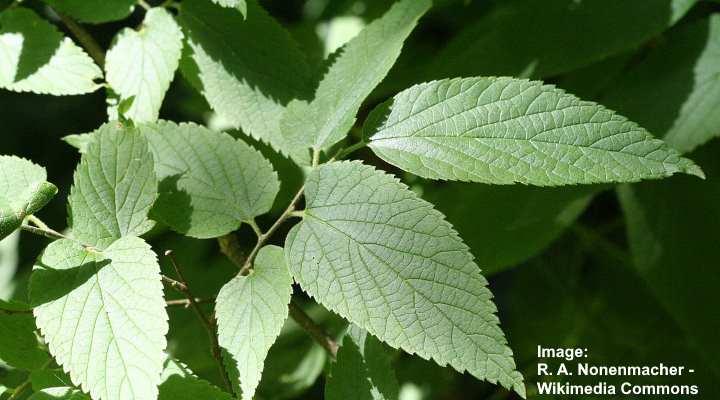
Common hackberry leaves
Hackberry Fruit: Small, round, fleshy berry-like drupes with a sweet taste. Each drupe contains a single brown seed. The fruits are popular with birds and humans alike.
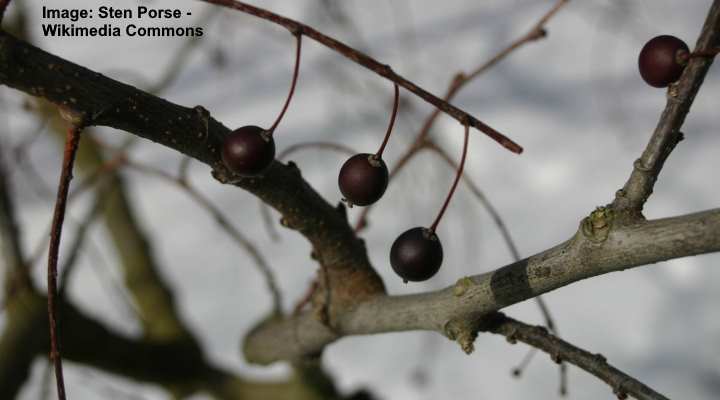
Common hackberry fruit
Hackberry Identification: Identify the common hackberry by its lanceolate leaves, clusters of yellowish fuzzy-looking flowers, and masses of purple berries in late summer. The landscape tree grows up to 60 ft. (18 m) tall with a spreading, rounded canopy.
Sugarberry (Celtis laevigata)
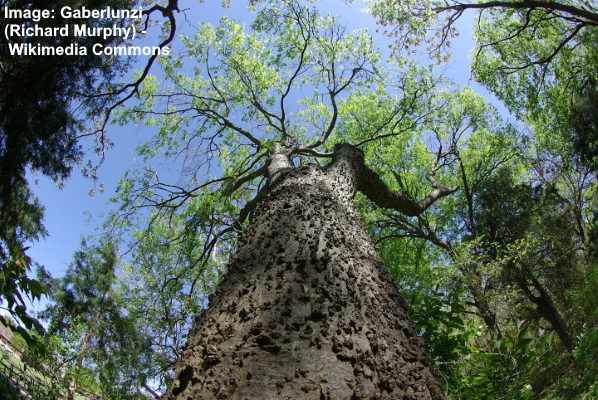
Sugarberry (Celtis laevigata) tree and bark
Also called the sugar hackberry, the sugarberry tree is a native, medium-sized tree with pointed leaves, small clusters of greenish flowers, and reddish-purple edible fruit. Sugarberry trees grow between 50 and 70 ft. (15 – 21 m) tall and 30 to 80 ft. (10 – 24 m) wide.
Another name for Celtis laevigata is southern hackberry. The USDA growing zones for sugarberries are 5 to 10. They are native in the Eastern United States, west to Texas and down to northern Mexico.
To differentiate between common hackberry and sugarberry, look at the leaves. Compared to the common hackberry, the sugarberry leaves have mostly smooth margins and are narrower. Sugarberry leaves grow between 2” and 4” (5 – 12 cm) long.
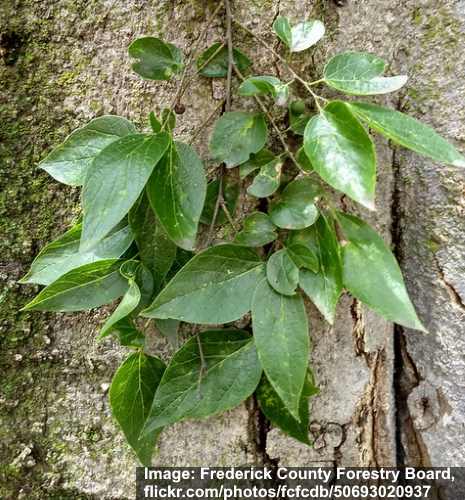
Sugarberry leaves
Compared to the common hackberry, the sugarberry doesn’t tolerate complete shade. The tree performs better in full sun to partial shade. However, it tolerates dry and wet soil conditions like the common hackberry.
One reason to grow sugar hackberry trees in your garden is that they are more resistant to witches’ broom. Although the tree disease doesn’t affect tree health, the clumps of nest-like branching can look unsightly.
Like most types of hackberries, the sugarberry tree has light brown or gray bark. The smooth bark on the tree’s trunk has raised, corky warts, making it easy to identify the tree in winter. The unusual bark also gives the sugar hackberry plenty of seasonal interest.
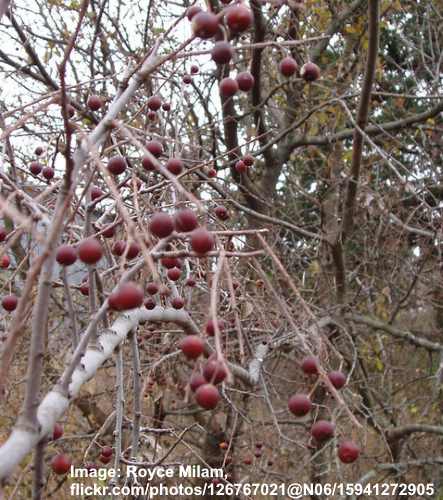
Sugarberry fruit
Netleaf Hackberry or Western Hackberry (Celtis reticulata, syn. Celtis laevigata reticulata)
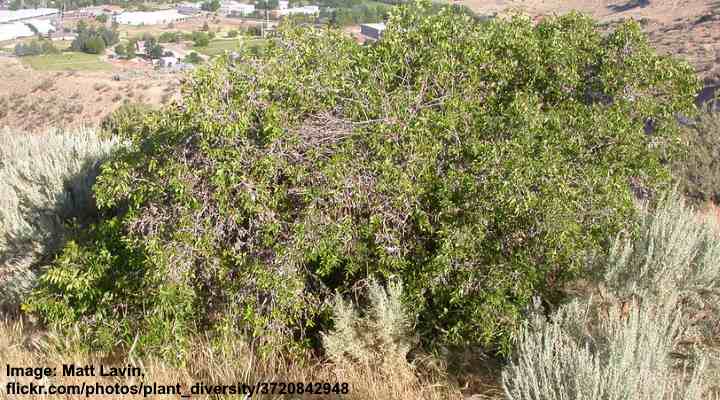
Netleaf /Western hackberry (Celtis reticulata)
The netleaf hackberry is a small deciduous tree with brownish-gray bark, lance-shaped leaves, small clusters of flowers, and reddish-brown to purple berries. This heat-loving and sun-loving tree grows between 20 and 30 ft. (6 – 10 m) high. In some places, the tree grows more like a large shrub.
An identifying feature of the netleaf hackberry is its light green, ovate to lanceolate leaves which tapered at the end. In addition, the leaves have sunken veins, creating a net-like pattern on the glossy blades—hence the common name netleaf. The oblong-ovate leaves measure 1.1” to 3.1” (3 – 8 cm) long.
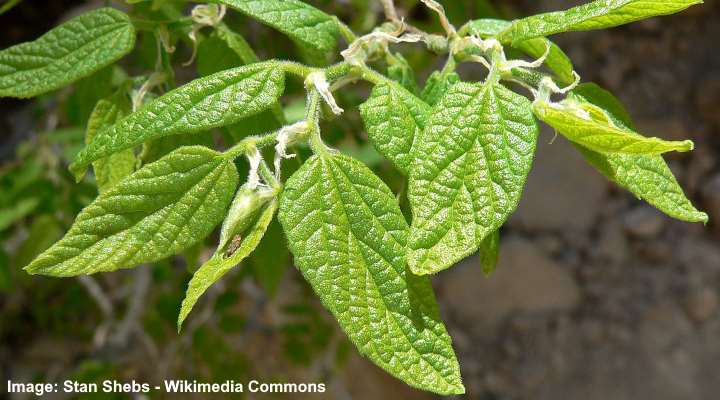
Celtis reticulata leaves
Other names for Celtis reticulata include western hackberry, netleaf sugar hackberry, palo blanco, and Douglas hackberry. The western hackberry native habitat ranges from Texas and Louisiana to Arizona. Most species of netleaf hackberries grow in Texas, New Mexico, Arizona, and northern Mexico.
Like all varieties of hackberry, the netleaf hackberry has corky bark with vertical ridges, crooked branches and twigs, and small spherical fruits.
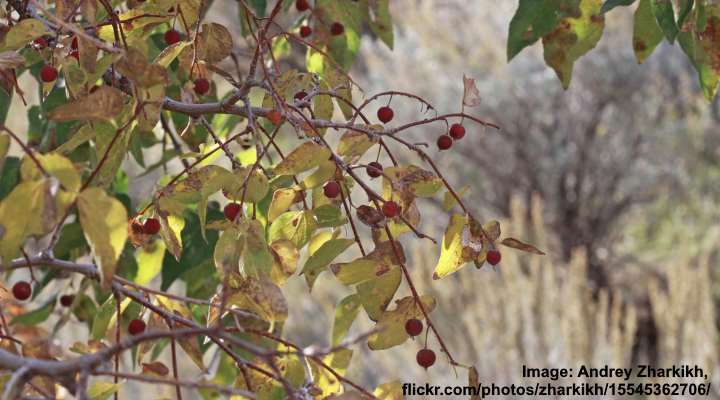
Celtis reticulata fruit
Growing in open landscapes, you can identify western hackberries by their wide spread and irregular, somewhat scraggly crown. This type of hackberry looks more like a vast shrub than an elegant shade tree.
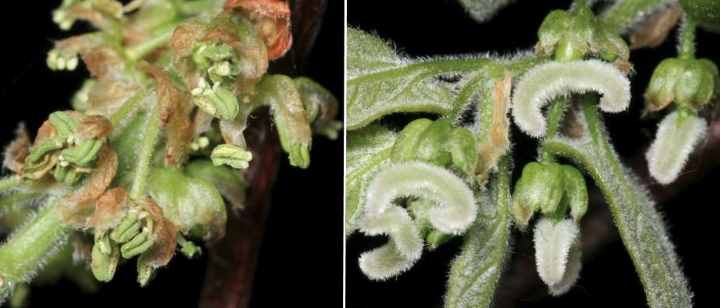
Celtis reticulata male flowers (left) and female flowers (right)
Desert Hackberry (Celtis ehrenbergiana)
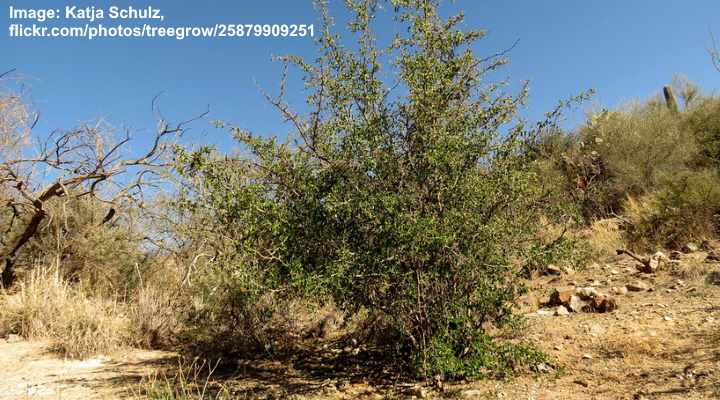
Desert hackberry (Celtis ehrenbergiana)
The desert hackberry is a large shrub or small tree with thorny zigzag branches, small oblong-ovate rough leaves, small green flower clusters, and orangey or red drupes. The hackberry shrub, with its dense foliage, grows 6 to 12 ft. (1.8 – 3.6 m) high and has an uneven crown.
The desert hackberry gets its name because it’s a hardy landscaping plant for hot, arid conditions. The shrub-like tree is also called spiny hackberry due to the sharp spines on the branches. Some botanists also give it the scientific name Celtis pallida or Celtis tala.
As a type of desert tree, desert hackberry thrives in sunny, dry conditions and rocky soils. In southern regions, the foliage stays evergreen, but the thick, leathery leaves turn yellow and drop in the fall in colder climates.
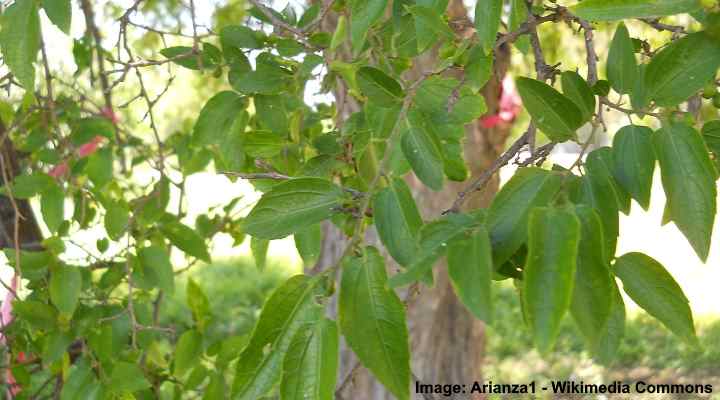
Desert hackberry leaves
Compared to other types of hackberries, the desert hackberry is one of the few shrubs in the genus.
Dwarf Hackberry (Celtis tenuifolia)
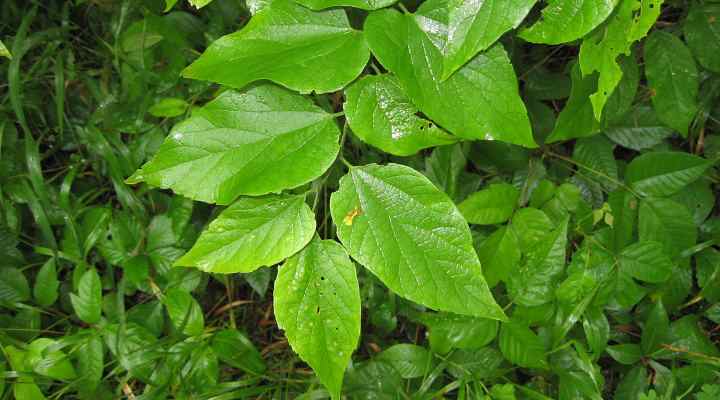
Dwarf hackberry (Celtis tenuifolia) leaves
Dwarf hackberry is a deciduous tree with heart-shaped or ovate leaves, tiny greenish flowers, orange fruits, and dark gray bark. As a type of dwarf tree, this hackberry species grows between 6 and 30 ft. (1.8 – 9 m) high and up to 15 ft. (4.5 m) wide.
Dwarf hackberry trees and large shrubs are native in states from Texas to the eastern coast of the US. However, the dwarf trees are primarily found in Alabama, Georgia, and the Carolinas.
Like all species of hackberries, the dwarf hackberry—also called Georgia hackberry—is identified by its corky, ridged bark, small globular fruits, and inconspicuous flower clusters. The drupes turn from orange, to red, before maturing as purple. Its leaves are glossy green and pointed ovate-shaped that turn an insignificant yellow in the fall.
The dwarf hackberry is an ideal landscaping tree or shrub for small gardens. The tree has a slow growth rate. It thrives in full sun and is intolerant of shade. However, the dwarf hackberry is fairly drought tolerant, so it doesn’t take much care to look after it in a garden landscape.
Related articles:
